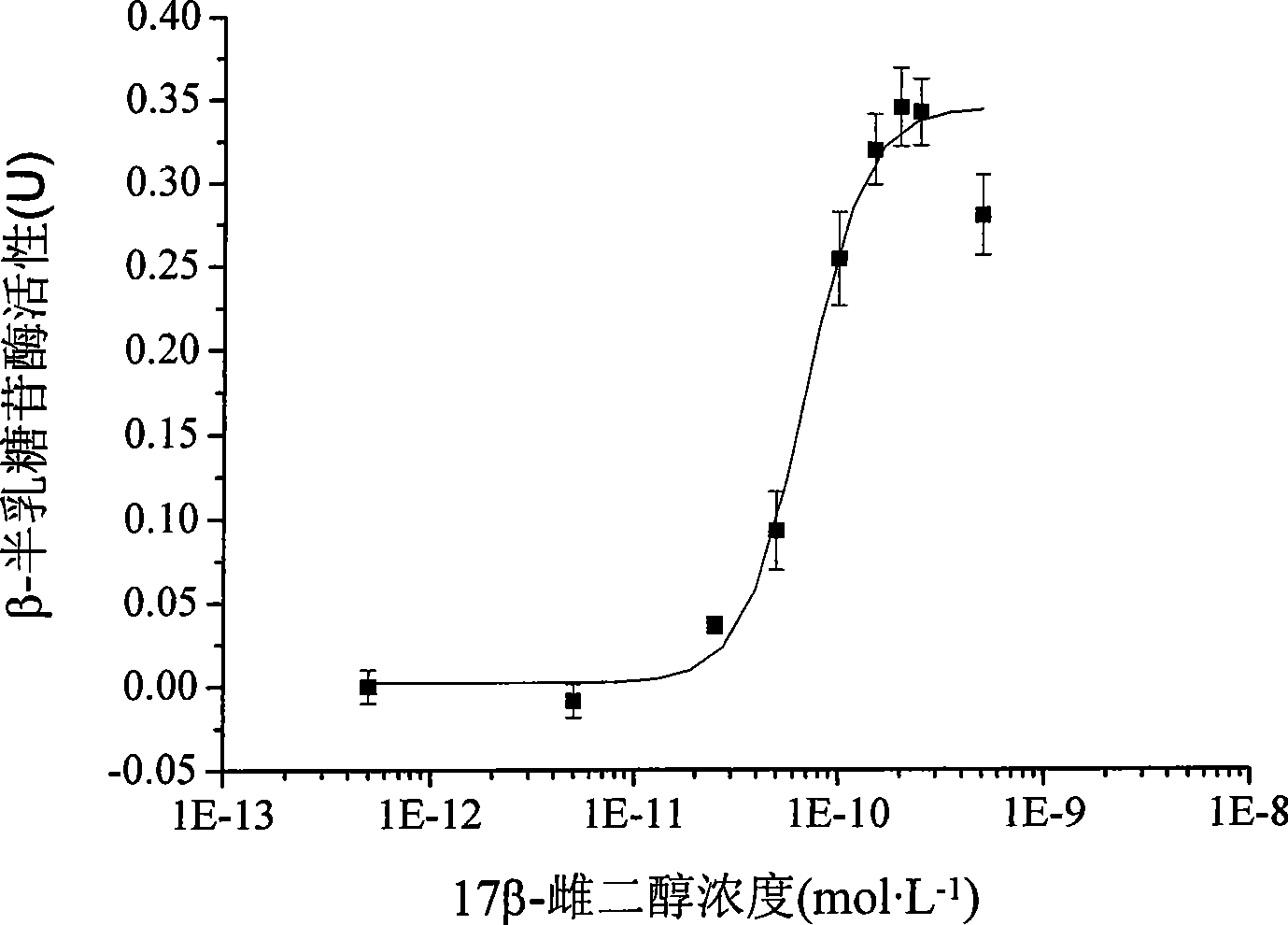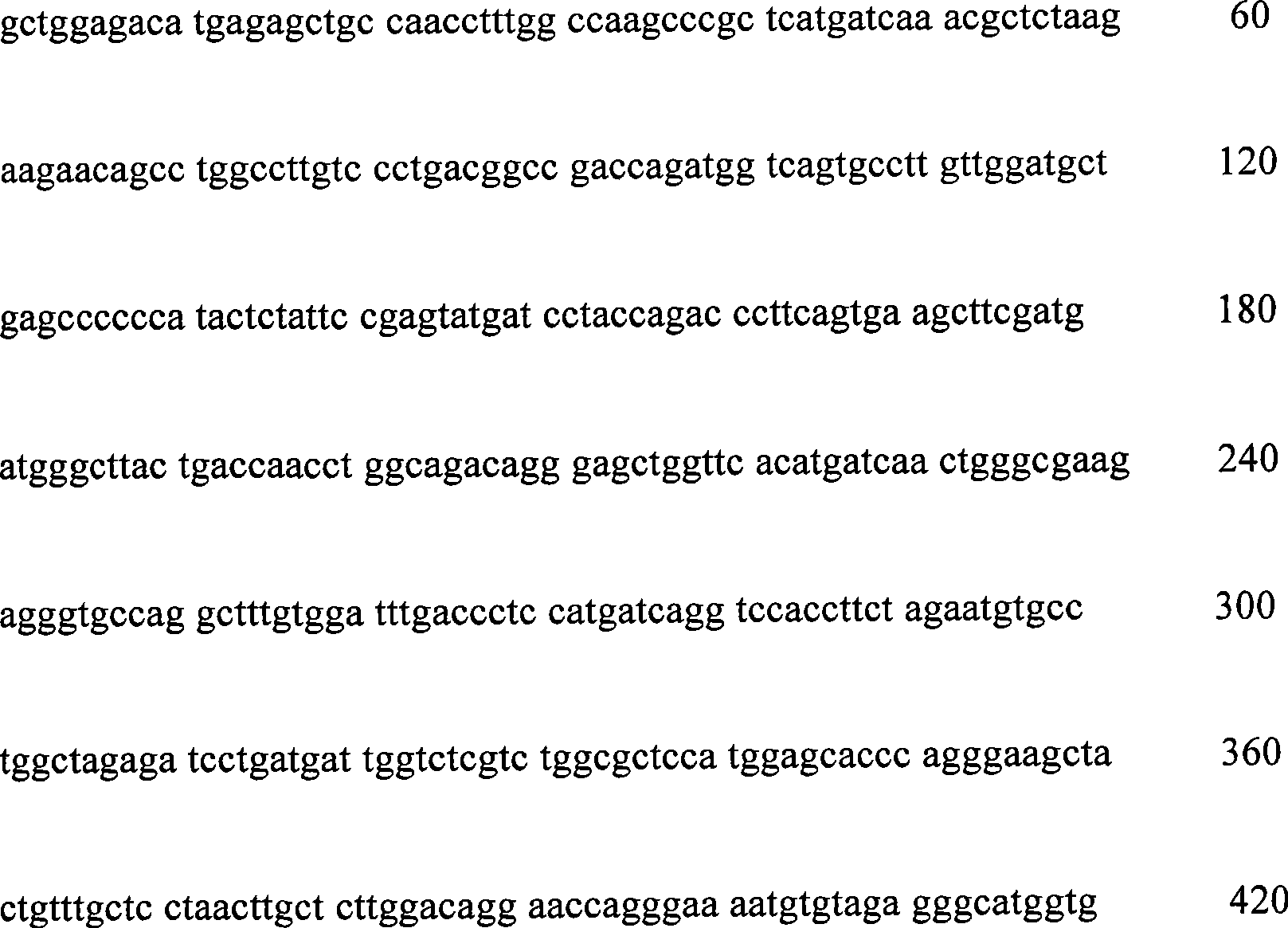Two-hybrid yeast for detecting estrogen-like compound in environment and biological test method
A detection environment, two-hybrid technology, applied in the direction of microorganism-based methods, biochemical equipment and methods, botany equipment and methods, etc., can solve the problems of false positive, lack of receptor coactivator, false negative, etc.
- Summary
- Abstract
- Description
- Claims
- Application Information
AI Technical Summary
Problems solved by technology
Method used
Image
Examples
Embodiment 1
[0035] Example 1: Preparation of Saccharomyces cerevisiae ER-GRIP1 (CGMCC No.2307) cells
[0036] 1. Construct the pGBKT7-hER yeast expression plasmid comprising the estrogen receptor gene fragment (ie, the sequence shown in SEQ ID No.1).
[0037] Firstly, PCR primers for the estrogen receptor ligand binding domain (hER LBD) were designed, and EcoR I and BamH I single restriction sites were introduced at the 5′ ends of the upstream and downstream primers respectively, that is, the upstream primer P1: 5′-TCGCCGGAATTCGCTGGAGACATGAGA -3' (the underlined part is the restriction site of EcoRI); downstream primer P2: 5'-TAACGCGGATCC
[0038]TCAGACTGTGGCAGG-3' (the underlined part is the restriction site of BamH I); carry out PCR amplification with 2.5 ng of the pASV3 plasmid (gifted by Professor Heery, University of Nottingham, UK) containing hER LBD (sequence shown in SEQ ID No.1) as template The PCR product (0.3pmol) was connected to the T-vector with T4 DNA ligase (1μL) to const...
Embodiment 2
[0045] Embodiment 2: Determination of 17β-estradiol (E 2 ) to draw a standard curve.
[0046] Yeast cell culture: inoculate the prepared two-hybrid Saccharomyces cerevisiae ER-GRIP1 (CGMCCNo.2307) cells into SD / -Trp / -Leu liquid medium (the composition is the same as in Example 1), and detect the bacterium liquid at 600nm Absorbance value (take the culture medium as blank), adjust the absorbance value to 0.1-0.2, and adjust the absorbance value at 600nm of the bacterial solution to 0.7-0.8 after culturing in an air-bath shaker at 30°C for 24 hours.
[0047] Draw the standard curve: take 0.995mL of the bacterial suspension into the corresponding Eppendorf tube, add 5μL of DMSO (blank) or 5μL of E 2 ; Transfer 200 μL of each of the above solutions to a 96-well plate in turn. Then at 130rpm, 30°C, vibrate and culture on a 96-well plate shaker for 2 hours; after the culture, first detect the absorbance value at 600nm; remove 150μL of yeast liquid; add 120μL of test buffer (3.33mL...
Embodiment 3
[0051] Example 3: Evaluation of the toxicity of estrogen-like pollutants in environmental samples using the two-hybrid Saccharomyces cerevisiae ER-GRIP1 (CGMCC No. 2307) biological assay method.
[0052] The influent and effluent water from different water plants in a certain city were collected as samples. Using solid phase extraction method, add dichloromethane and n-hexane to extract the estrogen-like pollutants in the sample, dry the extracted organic solvent in high-purity nitrogen, add DMSO to dissolve and prepare it within the linear range of the standard curve Test sample solution of any concentration.
[0053] Utilize the two-hybrid Saccharomyces cerevisiae ER-GRIP1 (CGMCCNo.2307) bioassay method described in Example 1 to evaluate the toxicity of estrogen-like pollutants in environmental samples, and the measurement results are compared with the single-hybrid recombinant estrogen receptor gene yeast method, mass spectrometry The results of the analytical methods were...
PUM
 Login to View More
Login to View More Abstract
Description
Claims
Application Information
 Login to View More
Login to View More - R&D
- Intellectual Property
- Life Sciences
- Materials
- Tech Scout
- Unparalleled Data Quality
- Higher Quality Content
- 60% Fewer Hallucinations
Browse by: Latest US Patents, China's latest patents, Technical Efficacy Thesaurus, Application Domain, Technology Topic, Popular Technical Reports.
© 2025 PatSnap. All rights reserved.Legal|Privacy policy|Modern Slavery Act Transparency Statement|Sitemap|About US| Contact US: help@patsnap.com



